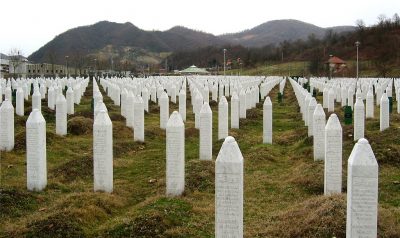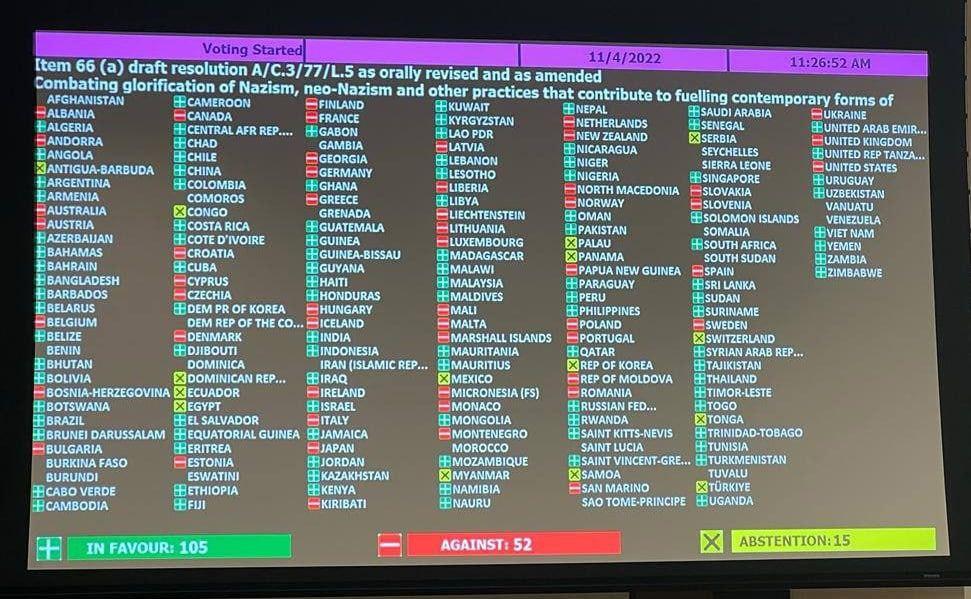Are There Bounds to Collective West’s Cynicism? Srebrenica and the Criminalization of the UN Judicial System. The Genocide Convention under the Jurisdiction of the War Criminals

All Global Research articles can be read in 51 languages by activating the Translate Website button below the author’s name (only available in desktop version).
To receive Global Research’s Daily Newsletter (selected articles), click here.
Click the share button above to email/forward this article to your friends and colleagues. Follow us on Instagram and Twitter and subscribe to our Telegram Channel. Feel free to repost and share widely Global Research articles.
Global Research Referral Drive: Our Readers Are Our Lifeline
***
There is a question that needs to be put to the leadership of Ecuador.
The next time there is a coup in their country and, as deposed Latin American officials regularly do, they also take refuge in a foreign embassy, after the appalling precedent they foolishly established the other day how safe will they be from their pursuers?
That is a matter they should be pondering gravely right now аs they contemplate the ruins of international law and the Vienna Convention following the ill-conceived incursion and abduction on foreign sovereign territory instigated on their orders in their own capital. But we do not intend to do their legal and intellectual work for them because this column is devoted to another topic.
In the United Nations General Assembly, a nasty resolution is being prepared to cement the narrative about the fabricated July 1995 genocide in Srebrenica.
The resolution’s purpose is three-fold:
- to officially endorse the dubious findings of the International Criminal Tribunal for the Former Yugoslavia,
- to condemn “Srebrenica genocide denial,” and to
- mandate that henceforth July 11 should be observed as the international Srebrenica genocide day, akin one supposes to Women’s Day on March 8.
The last such attempt to force Srebrenica down the international community’s throat was in 2015.
It was sponsored unashamedly in the Security Council of the United Nations by the Perfidious Albion, the godfather of all genocides this side of antiquity, stretching from North America to India and with everywhere in between, not forgetting the unhappy Emerald Isle of Ireland, of course.
That slimy attempt to tar an entire nation, the Serbs in this particular case, by sullying them collectively with the most heinous crime known in international law failed only because it was vetoed by Russia.
The authors of the pending resolution assume that the clever change of venue to the General Assembly, where there are no inconvenient procedural obstacles to their machinations, should do the trick, thus avoiding a repetition of the 2015 failure. They hope that cajoling the usual assortment of obscure Pacific island statelets and subservient “allies” drawn from the four corners of the Earth should suffice to produce a respectable General Assembly vote in support of their Srebrenica resolution. It matters not to them that most of those strong-armed and blackmailed governments have no stake whatsoever in this matter and that their public for the most part have not even heard of Srebrenica.
The fact that such a resolution will have been sponsored by Germany and Rwanda, though of course it was conceived and written not by them but by their controllers, encapsulates the perfidy. Germany embodies genocide running into millions, and not just in Europe but in Southwest Africa as well. Rwanda, an obedient African protectorate of the collective West, exemplifies racially motivated mass killing on a ghastly scale in the 1990s, covertly managed by Western special services but brilliantly deconstructed and exposed by Prof. Edward Herman and David Peterson. The fact that these two governments tainted by genocide were tasked in the UN by their hegemonic masters to table a resolution on the subject of genocide, to morally compromise a nation that historically has itself been a victim a genocide, speaks volumes about the cynicism of this sick project’s degenerate authors.
The false narrative of “Srebrenica genocide” has been picked apart relentlessly over the last decade and a half, knocking out every one of its propaganda props. As Dr. Efraim Zuroff, director of the Simon Wiesenthal Centre in Jerusalem, said a few days ago “according to the original definition of genocide, which holds that it is an attempt to destroy an entire ethnic group, the crime committed in Srebrenica cannot be an act of genocide. Serbian forces let go all women and children before executing the men, some of whom were combatants. I do not consider the General Assembly of the United Nations to be competent to determine whether or not an event was genocide.”
The evidence strongly supports Zuroff’’s position. Over twenty years after the event, there is no proof that Serbian forces had the required special intent (dolus specialis) to exterminate the population of Srebrenica, not to speak of their coreligionists throughout Bosnia.
As Zuroff observed, the reproductive part of the population was unharmed, which directly contradicts the existence of genocidal intent. Furthermore, autopsy reports show that there were remains of a total of 1,920 individuals in Srebrenica mass graves, which is less than a quarter of the wildly inflated official figure of 8,000 victims. Pattern of injury analysis reveals that even of those about 70% died of a variety of causes, mainly combat injuries, and that at most about 800 exhibited injuries consistent with execution.
That number is roughly equivalent to the number of Serbian civilians that were killed in raids on surrounding Serbian villages carried out from the UN protected enclave of Srebrenica during the three years that preceded its capture.
It was also established, on the basis of survivor statements, that in the period immediately following the Serbian forces’ entry into Srebrenica, on July 11, 1995, fierce combat continued with the 28th Division of the Army of Bosnia and Herzegovina, as it was breaking out of Serbian encirclement. That resulted in several thousand combat deaths that were entirely legitimate under international law and therefore could not be attributed to “genocide”. However, collective West propaganda and the illegal Tribunal at the Hague that was set up specifically to reach preordained legal and factual conclusions about the war in Bosnia were happy to conflate combat casualties with real victims in order to fix the 8,000 victims figure that they regarded as the psychological minimum for the allegation of genocide to appear credible.
The politically motivated Srebrenica resolution is due to be introduced on the General Assembly’s agenda toward the end of April, 2024.
Coincidentally, that also happens to be a date of great significance to a real genocide, commemorated at roughly the same time.
On April 22, 1945, just days before the defeat of the Axis and the end of World War II, the few surviving prisoners of the Jasenovac concentration camp in Nazi-aligned “Independent State of Croatia,” called by Israeli historian Gideon Greif the “Auschwitz of the Balkans,” staged a rebellion, with a handful managing to escape. It is estimated that between 1941 and 1945 in Jasenovac about 600,000 victims, Serbs, Jews and Roma, perished for reasons of their race or ethnicity.
And yet this anniversary of a real genocide is of no interest to the German government. It chose pointedly to ignore it when signing on to the baseless Srebrenica resolution. If it had a shred of honour and decency it would not have done so, regardless of the instructions of its Transatlantic overseers. The appalling details of the uninterrupted four-year butchery in Jasenovac are not in dispute, having horrified even hardened SS officers. It was regarded with disgust by the German commanding general in Zagreb Glaise von Horstenau and the top German diplomat in the Balkans, Hermann Neubacher. The Jasenovac death camp was run and atrocities there were committed by the Croat equivalent of Ukrainian Banderites, that is correct, but under international law, as the occupying power, it is Germany that had overall responsibility to ensure the safety of civilians and to prevent their indiscriminate extermination.
By choosing not to interfere with the bestiality of its local Croatian satellites, instead of preventing Germany in fact facilitated those outrages.
We now have a clear answer to the question in the title of this text. No, there seem to be no limits to their contemptible cynicism and hypocrisy. If Germany were truly looking for a way to assuage its conscience and to demonstrate repentance, it would be submitting in the General Assembly a resolution to condemn one of the authentic genocides, in Jasenovac and throughout Croatia during World War II, in the perpetration of which it played at least a facilitating role. It would not be virtue signalling with the politically concocted “genocide” in Srebrenica, made up out of thin air to humiliate and bully a proud nation that refuses to submit to the dictates of the collective West (of which Germany is a subservient member) today, just as its grandparents had refused to bow to Hitler and his minions in 1941.
Sadly, whatever Germany and its Transatlantic handlers ultimately do, it would be naïve to expect that they will receive their proper comeuppance from the cowardly Serbian government. That government will not, as it should and is perfectly entitled to do, introduce in the General Assembly its own resolution calling on the world community to recognise and condemn the genocidal extermination of the Serbian people in Jasenovac and elsewhere in Banderite Croatia during World War II.
In fact, it is a matter of great interest to see whether in fear of its Western masters that miserable government will even dare to vote against occupied Germany’s and pathetic Rwanda’s resolution in the General Assembly, blaming the Serbian people for the fictitious “genocide” in Srebrenica.
After all, in November 2022 the Serbian government instructed their representative in the UN to shamefully abstain on the resolution condemning the glorification of Nazism, racism, and xenophobia, evils from which their own people had suffered immeasurably. So on the upcoming Srebrenica resolution, all bets are off.
*
Note to readers: Please click the share button above. Follow us on Instagram and Twitter and subscribe to our Telegram Channel. Feel free to repost and share widely Global Research articles.
Stephen Karganovic is president of “Srebrenica Historical Project,” an NGO registered in the Netherlands to investigate the factual matrix and background of events that took place in Srebrenica in July of 1995. He is a regular contributor to Global Research.
Featured image: Gravestones at the Potočari genocide memorial near Srebrenica (Source: Wikimedia Commons)
By Stephen Karganovic
Rethinking Srebrenica examines the forensic evidence of the alleged Srebrenica “massacre” possessed by the International Criminal Tribunal for the former Yugoslavia (ICTY) in The Hague. Even though the ICTY created more than 3,500 autopsy reports, many of these autopsy reports were based on bone fragments, which do not represent complete bodies. An examination of the matching femur bones found reveals that there were only about 1,900 complete bodies that were exhumed. Of these, some 1,500 autopsy reports indicated a cause of death consistent with battlefield casualties. Only about 400 autopsy reports indicated execution as a cause of death, as revealed by ligatures and blindfolds. This forensic evidence does not warrant the conclusion of a genocide having taken place.
Karganovic examines the events that took place in Srebrenica in July 1995 in a wholistic manner instead of restricting it to a three-day event. The ten chapters cover:
1) Srebrenica: A Critical Overview;
2) Demilitarization of the UN Safe Zone of Srebrenica;
3) Genocide or Blowback?;
4) General Presentation and Interpretation of Srebrenica Forensic Data (Pattern of Injury Breakdown);
5) An Analysis of the Srebrenica Forensic Reports Prepared by the ICTY Prosecution Experts;
6) An Analysis of Muslim Column Losses Attributable to Minefields, Combat Activity, and Other Causes;
7) The Genocide Issue: Was there a Demonstrable Intent to Exterminate All Muslims?;
8) ICTY Radio Intercept Evidence;
9) The Balance Sheet; and
10) Srebrenica: Uses of the Narrative.
- ASIN: B0992RRJRK
- Publisher: Unwritten History, Inc.; 2 edition (July 8 2021)
- Language: English



 Rethinking Srebrenica
Rethinking Srebrenica